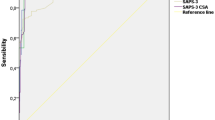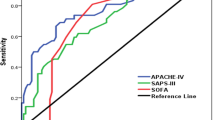Abstract
Objective
To compare three scoring systems, the Acute Physiology and Chronic Health Evaluation (APACHE) II, the Simplified Acute Physiology Score (SAPS) II and a modified Mortality Probability Model II (ICU cancer mortality model, ICMM) for their prognostic value for mortality during hospital stay in a group of cancer patients admitted to a medical ICU.
Design
Prospective cohort study.
Setting
Medical ICU of a tertiary care hospital.
Patients
Two hundred forty-two consecutive cancer patients admitted to the ICU.
Measurements and results
Variables included in APACHE II, SAPS II and the ICMM scores as well as demographic data were assessed during the first 24 h of stay in the ICU. Hospital mortality was measured; it was 44%. Calibration for all three scoring systems was acceptable, SAPS II yielded a significantly superior discrimination between survivors and non-survivors. The areas under the receiver operating characteristic curves were 0.776 for APACHE II, 0.825 for SAPS II and 0.698 for the ICMM.
Conclusion
The SAPS II was superior to APACHE II and ICMM. The newly developed ICMM does not improve mortality prediction in critically ill cancer patients.


Similar content being viewed by others
References
Sculier JP, Markiewicz E (1991) Medical cancer patients and intensive care. Anticancer Res 11:2171–2174
Baumann WR, Jung RC, Koss M, Boylen CT, Navarro L, Sharma OP (1986) Incidence and mortality of adult respiratory distress syndrome: a prospective analysis from a metropolitan hospital. Crit Care Med 14:1–4
Sussman NL, Lake JR (1996) Treatment of hepatic failure 1996: current concepts and progress toward liver dialysis. Am J Kidney Dis 27:605–621
Krafft P, Fridrich P, Pernerstorfer T, Fitzgerald RD, Koc D, Schneider B, Hammerle AF, Steltzer H (1996) The acute respiratory distress syndrome: definitions, severity and clinical outcome. An analysis of 101 clinical investigations. Intensive Care Med 22:519–529
Marik PE, Craft M (1997) An outcomes analysis of in-hospital cardiopulmonary resuscitation: the futility rationale for do not resuscitate orders. J Crit Care 12:142–146
The British Thoracic Society Research Committee and The Public Health Laboratory Service (1992) The aetiology, management and outcome of severe community-acquired pneumonia on the intensive care unit. Respir Med 86:7–13
Massion PB, Dive AM, Doyen C, Bulpa P, Jamart J, Bosly A, Installe E (2002) Prognosis of hematologic malignancies does not predict intensive care mortality. Crit Care Med 30:2260–2270
Sculier JP, Paesmans M, Markiewicz E, Berghmans T (2000) Scoring systems in cancer patients admitted for an acute complication in a medical intensive care unit. Crit Care Med 28:2786–2792
Staudinger T, Stoiser B, Mullner M, Locker GJ, Laczika K, Knapp S, Burgmann H, Wilfing A, Kofler J, Thalhammer F, Frass M (2000) Outcome and prognostic factors in critically ill cancer patients admitted to the intensive care unit. Crit Care Med 28:1322–1328
Groeger JS, Lemeshow S, Price K, Nierman DM, White P Jr, Klar J, Granovsky S, Horak D, Kish SK (1998) Multicenter outcome study of cancer patients admitted to the intensive care unit: a probability mortality model. J Clin Oncol 16:761–770
Knaus WA, Wagner DP, Draper EA, Zimmerman JE, Bergner M, Bastos PG, Sirio CA, Murphy DJ, Lotring T, Damiano A (1991) The APACHE III prognostic system. Risk prediction of hospital mortality for critically ill hospitalized adults. Chest 100:1619–1636
Le Gall JR, Lemeshow S, Saulnier F (1993) A new simplified acute physiology score (SAPS II) based on a European/North American multicenter study. JAMA 270:2957–2964
Lemeshow S, Hosmer DW Jr (1982) A review of goodness-of-fit statistics for use in the development of logistic regression models. Am J Epidemiol 115:92–106
Weinstein MC, Fineberg HV (1980) Clinical decision analysis. Saunders, Philadelphia
DeLong ER, DeLong DM, Clarke-Pearson DL (1988) Comparing the areas under two or more correlated receiver operating characteristic curves: a nonparametric approach. Biometrics 44:837–845
Zweig MH, Campbell G (1993) Receiver-operating characteristic (ROC) plots: a fundamental evaluation tool in clinical medicine. Clin Chem 39:561–577
Rosenberg AL (2002) Recent innovations in intensive care unit risk-prediction models. Curr Opin Crit Care 8:321–330
Patel PA, Grant BJB (1999) Application of mortality prediction systems to individual intensive care units. Intensive Care Med 25:977–982
Carson SS, Bach PB (2001) Predicting mortality in patients suffering from prolonged critical illness: an assessment of four severity-of-illness measures. Chest 120:928–933
Reina A, Vazquez G, Aguayo E, Bravo I, Colmenero M, Bravo M (1997) Mortality discrimination in acute myocardial infarction: comparison between APACHE III and SAPS II prognosis systems. Intensive Care Med 23:326–330
Bein T, Frohlich D, Pomsl J, Forst H, Pratschke E (1995) The predictive value of four scoring systems in liver transplant recipients. Intensive Care Med 21:32–37
Fiaccadori E, Maggiore U, Lombardi M, Leonardi S, Rotelli C, Borghetti A (2000) Predicting patient outcome from acute renal failure comparing three general severity of illness scoring systems. Kidney Int 58:283–292
Guiguet M, Blot F, Escudier B, Antoun S, Leclercq B, Nitenberg G (1998) Severity of illness scores for neutropenic patients in an intensive care unit: which is the best predictor? Do multiple assessment times improve the predictive value? Crit Care Med 26:488–493
Kroschinsky F, Weise M, Illmer T, Haenel M, Bornhaeuser M, Hoeffken G, Ehninger G, Schuler U (2002) Outcome and prognostic features of intensive care unit treatment in patients with hematological malignancies. Intensive Care Med 28:1294–1300
Groeger JS, White P, Nierman DM, Glassmann J, Shi W, Horak D, Price K (1999) Outcome of cancer patients requiring mechanical ventilation. J Clin Oncol 17:991–997
Lemeshow S, Le Gall JR (1994) Modeling the severity of illness of ICU patients. A systems update. JAMA 272:1049–1055
Ferrand E, Robert R, Ingrand P, Lemaire F (2001) Withholding and withdrawal of life support in intensive-care units in France: a prospective survey. Lancet 357:9–14
Schapira DV, Studnicki J, Bradham DD, Wolff P, Jarrett A (1993) Intensive care, survival and expense of treating critically ill cancer patients. JAMA 269:783–786
Brunet F, Lanore JJ, Dhainaut JF, Dreyfus F, Vaxelaire JF, Nouira S, Giraud T, Armaganidis A, Monsallier JF (1990) Is intensive care justified for patients with haematological malignancies? Intensive Care Med 16:291–297
Azoulay E, Moreau D, Alberti C, Leleu G, Adrie C, Barboteu M, Cottu P, Levy V, Le Gall JR, Schlemmer B (2000) Predictors of short-term mortality in critically ill patients with solid malignancies. Intensive Care Med 26:1817–1823
Faber-Langendoen K, Caplan AL, McGlave PB (1993) Survival of adult bone marrow transplant patients receiving mechanical ventilation: a case for restricted use. Bone Marrow Transplant 12:501–507
Crawford SW (1998) Using outcome research to improve the management of blood and marrow transplant recipients in the intensive care unit. New Horiz 6:69–74
Khassawneh BY, White P, Anaissie EJ, Barlogie B, Hiller FC (2002) Outcome from mechanical ventilation after autologous peripheral blood stem cell transplantation. Chest 121:185–188
Epner DE, White P, Krasnoff M, Khanduja S, Kimball KT, Knaus WA (1996) Outcome of mechanical ventilation for adults with hematologic malignancy. J Investig Med 44:254–260
Shaw A, Weavind L, Feeley T (2001) Mechanical ventilation in critically ill cancer patients. Curr Opin Oncol 13:224–228
Kongsgaard UE, Meidell NK (1999) Mechanical ventilation in critically ill cancer patients: outcome and utilisation of resources. Support Care Cancer 7:95–99
Author information
Authors and Affiliations
Corresponding author
Rights and permissions
About this article
Cite this article
Schellongowski, P., Benesch, M., Lang, T. et al. Comparison of three severity scores for critically ill cancer patients. Intensive Care Med 30, 430–436 (2004). https://doi.org/10.1007/s00134-003-2043-1
Received:
Accepted:
Published:
Issue Date:
DOI: https://doi.org/10.1007/s00134-003-2043-1




